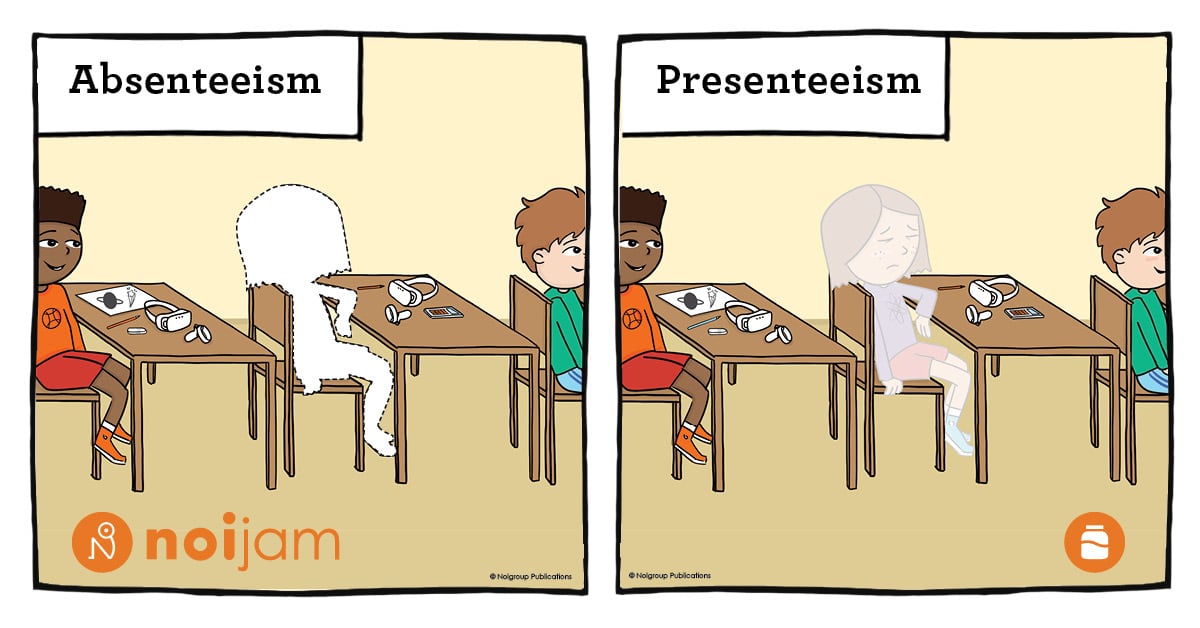Guest writer, Jen Norton, investigates the impact of chronic pain on children’s ability to present at school and to be present at school. Namely: pain-related absenteeism and its prevalence for kids with chronic pain; presenteeism and how it manifests for children at school; and ways to approach these themes with curiosity in our research, work, and everyday interactions.

Have you ever considered school as a child’s main occupation? Plenty of adult-based research looks at the impact of pain on an adult’s occupation and contribution to the workforce, but what happens when we re-frame school as a childhood occupation? By re-framing, the paediatric context of this article quickly becomes more relatable. So, I invite you to join me on a quick journey.
First things first – absenteeism
The average adult who works full-time has access to approximately ten paid sick days per year. That’s two full weeks, Monday to Friday, off work, not including our joyful four weeks of recreation leave. If you’re lucky, you won’t spend your full allocation and it will roll over to the new year to accumulate.
Now, let’s consider that school is one of the main occupations of children aged 5-18 years. Did you know that children with chronic pain miss approximately 22% of school days? (Norton & Southon, 2020). That’s close to nine weeks, or 45 days per year (even more staggering when you consider there are only approximately 40 weeks in an Australian school year). That is a total of 270 hours lost to learning, occupation, play, and socialising. Imagine telling your boss that you were likely to miss 45 days of work this year? Consider the impact on your ability to achieve quality outcomes, develop your career, reinforce old skills, and master new ones.
Our second theme – presenteeism
Have you ever arrived at work and thought, ‘I’m just a visitor at work today’? Maybe you had a weekend away celebrating a wedding, or it rained non-stop and so your kids watched Frozen on repeat for the 87th time, or you slept terribly the night before. You are physically at work but not mentally, emotionally, and energetically present. That’s presenteeism. Did you know that kids challenged by chronic pain feel like this too? They’ve arrived at school and put their hand up to say ‘Yes Miss, I’m present’ when their name is read out on the roll. They are at school but are a ‘visitor’ at their workplace today. Physically present but unable to engage in participating and achieving at school to the best of their ability.
We don’t (yet) have data to say how many kids with chronic pain are experiencing presenteeism (which is not exclusive to absenteeism). However, with one in four children experiencing chronic pain, their occupation of school is significantly affected.
And finally, some curious questions to ponder:
- How are we supporting kids with chronic pain to access, achieve and engage in their main occupation – school – given factors such as absenteeism AND presenteeism? (Dr Joshua Pate is currently working on an awesome project to teach kids about the mysterious science of pain!)
- How do we support kids with chronic pain BEFORE they reach the threshold criteria to access tertiary treatment and services? (i.e., before chronic pain becomes SEVERE chronic pain).
- Can we harness the power of our teachers (my amazing colleague Bec Fechner has some thoughts about this) who work with kids at their occupation of school?
- Could we upskill, build confidence, and empower community-based and non-tertiary allied health professionals to work in this space? (Watch this space – it’s an exclusive sneak peek of a future research question!)
If you want to know more or have had a ‘lightbulb moment’, feel free to reach out via email on my contact details below!
– Jen Norton
Paediatric physiotherapist & early career researcher
Jennifer.norton@uts.edu.au
Norton, J., & Southon, N. (2020). Exploring the Prevalence of Pediatric Chronic Pain and School Absenteeism for Therapists Working in Schools: A Systematic Review with Meta-Analysis. Physical & Occupational Therapy in Pediatrics, 1–17. https://doi.org/10.1080/01942638.2020.1836705
Want more?
Images from Zoe and Zak’s Pain Hacks, Book 3: Zoe and Zak’s Brainy Adventure! © Joshua W. Pate, Noigroup Publications (In press 2022)

comments